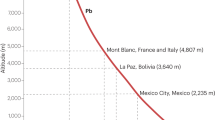Abstract
Travel to high altitude exposes the human body to a variety of stresses, the most prominent being reduced available oxygen with increase in altitude due to reduced partial pressure of oxygen. Several physiological responses are initiated in the human body to promote faster acclimatization to these adverse environmental conditions. These physiological and molecular readjustments encompassing acclimatization, namely, hypoxic ventilatory response, diuresis, increased cardiac output, improved oxygen carrying capacity and cerebral blood flow, Hypoxia inducible factor 1 stabilization, etc., converge to a single outcome, ensuring optimal bioavailability of oxygen. In this article, we describe the basic acclimatization framework mentioned above.
Similar content being viewed by others
Suggested Reading
S S Purkayastha, U S Ray, B S Arora, P C Chhabra, L Thakur, P Bandopadhyay and W Selvamurthy, Acclimatization at high altitude in gradual and acute induction, Journal of Applied Physiology, Vol.79, No.2, pp.487–492, 1995.
R N Pittman, Regulation of Tissue Oxygenation, Eds. D N Granger, J P Granger, Morgan and Claypool Life Sciences, California, p.19, 2011.
J P R Brown and M P WGrocott, Humans at altitude: physiology and pathophysiology, Continuing Education in Anaesthesia, Critical Care & Pain, doi: 10.1093/bjaceaccp/mks047, 2012.
N R Prabhakar, O2 sensing at the mammalian carotid body: why multiple O2 sensors and multiple transmitters?, Experimental Physiology, Vol.91, No.1, pp.17–23, 2006.
M V Singh, A K Salhan, S B Rawal, A K Tyagi, N Kumar, S S Verma and W Selvamurthy, Blood gases, hematology, and renal blood flow during prolonged mountain sojourns at 3500 and 5800 m, Aviation, Space and Environmental Medicine, Vol.74, No.5, pp.533–536, 2003.
J T Berg, S Ramanathan and E R Swenson, Inhibitors of hypoxic pulmonary vasoconstriction prevent high-altitude pulmonary edema in rats, Wilderness & Environmental Medicine, Vol.15, No.1, pp.32–37, 2004.
R Naeije, Physiological adaptation of the cardiovascular system to high altitude, Progress in Cardiovascular Diseases, Vol.52, No.6, pp.456–466, 2010.
D Martin and J Windsor, From mountain to bedside: understanding the clinical relevance of human acclimatisation to high-altitude hypoxia, Postgraduate Medical Journal, Vol.84, pp.622–627, 2008.
J S Windsor and G W Rodway, Heights and haematology: the story of haemoglobin at altitude. Postgraduate Medical Journal, Vol.83, No.977, pp.148–151, 2007.
P D Wagner, H EWagner, B M Groves, A Cymerman and CS Houston, Hemoglobin P(50) during a simulated ascent of Mt. Everest, Operation Everest II. High Altitude Medicine & Biology, Vol.8, No.1, pp.32–42, 2007.
S J Lucas, K R Burgess, K N Thomas, J Donnelly, K C Peebles, R A Lucas, J L Fan, J D Cotter, R Basnyat and P N Ainslie, Alterations in cerebral blood flow and cerebrovascular reactivity during 14 days at 5050 m, Journal of Physiology, Vol.589, (Pt 3), pp.741–753, 2011.
J B West, The Physiologic Basis of High-Altitude Diseases, Annals of Internal Medicine, Vol.141, pp.789–800, 2004.
D R Woods, M Stacey, N Hill and N de Alwis, Endocrine aspects of high altitude acclimatization and acute mountain sickness, Journal of the Royal Army Medical Corps., Vol.157, No.1, pp.33–37, 2011.
G Höpfl, O Ogunshola and M Gassmann, Hypoxia and high altitude. The molecular response, Advances in Experimental Medicine & Biology, Vol.543, pp.89–115, 2003.
S Sarkar, P K Banerjee and W Selvamurthy, High altitude hypoxia: an intricate interplay ofoxygen responsivemacroevents andmicromolecules. Molecular and Cellular Biochemistry, Vol.253, Nos.1–2, pp.287–305, 2003.
Author information
Authors and Affiliations
Corresponding author
Additional information
Sonam Chawla is an MTech in Biotechnology. Currently she is pursuing her doctoral studies in Defence Institute of Physiology and Allied Sciences, Delhi as a CSIR Research Fellow.
Shweta Saxena is a research scientist at Defence Institute of Physiology and Allied Sciences, Delhi. She is involved in designing pharmacological strategies for rapid acclimatization to high altitude with an aim to improve performance of Indian soldiers during high-altitude deputations.
Rights and permissions
About this article
Cite this article
Chawla, S., Saxena, S. Physiology of high-altitude acclimatization. Reson 19, 538–548 (2014). https://doi.org/10.1007/s12045-014-0057-3
Published:
Issue Date:
DOI: https://doi.org/10.1007/s12045-014-0057-3




